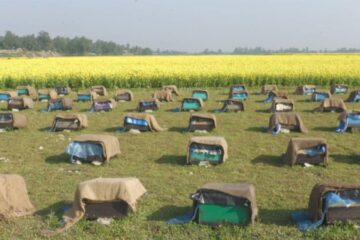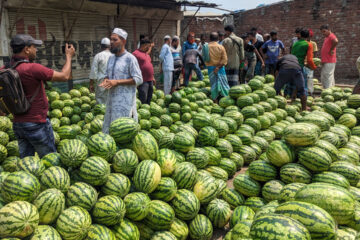BDRunner Online:
FENI, Sept 06:- About one and a half thousand hectares of agricultural land has been buried in the sand brought by the flow of flood water. Also, 85 percent of the land’s saplings have been destroyed. The information was confirmed by the Upazila Agriculture Department. Farmers of Parashuram in the district are suffering from fear and anxiety as the agricultural land has become unfit for cultivation due to sand.
According to Water Development Board sources, severe floods in Parashuram caused erosion at 14 places in Muhuri, Kahua and Ceylonia River flood control dams.
Locals said that the sand that came with the flow of flood water has frozen in the agricultural land. Even though the flood water receded, the sand accumulated in the agricultural land did not move. The owners of these lands, which are unsuitable for cultivation, are now in various fears and worries. They have doubts about whether they can remove the sand accumulated in the agricultural land.
Several farmers affected by the flood said that in July and August, large areas of the upazila Mirzanagar, Chithlia, Buxmahmud Union and Parshuram municipality were affected by the floods. Last, on August 20, 90 percent of Parashuram’s area was submerged in 8 to 15 feet of water due to the floods of Indian mountain landslides. Landslides caused erosion in 5 places on the Ceylonia river embankment, 7 places on Muhuri river embankment and 2 places on Kahua River embankment. Sand has been washed away by the flood water through these breaks. In various areas of Parashuram, cultivated land has been filled with up to 5 feet of sand.
According to the information of the Upazila Agriculture Office, the target of Aman paddy cultivation was set at 5 thousand 860 hectares of land in the current season. Out of this, 4 thousand 829 hectares of land was cultivated with Aman rice. However, 4,105 hectares of plantations, which is 85 percent of the total plantation, have been destroyed in the flood. Most of these lands are filled with silt washed away by floods. Hundreds of ponds have also been filled. Locals say that most of the land has become unfit for cultivation due to sand.
Sohag Bhuiyan of East Alka village of Chithlia Union said that 4-5 feet of sand has accumulated in all the lands here.
Zafar Ahmed, a farmer of Rangamatia village, said, I cultivated three kani land with barga. All the land has ended up with sand. I am alive by eating rice and pulses given by people. I don’t know how the future will go.
Local farmers say that if the damage to the land is not repaired quickly, it will not be possible to cultivate the land for a long time.
Parshuram Upazila Agriculture Officer (Acting) asked about this. Sifat Hasan said that 85 percent of the crops were destroyed in the flood. Aman should be planted by making new seedlings or seedbeds.
However, as the sand accumulates, it cannot be cultivated unless it is removed quickly, and farmers will suffer.
Local farmers question whether the accumulated sand can be removed to protect the agricultural land. Zahirul Islam, a resident of Uttar Kawtali village of Mirzanagar union, said that most of the land of this village has been covered by the sand washed away by the erosion of two places of Muhuri river embankment in Kashinagar. Crops are buried under several feet of sand. When asked whether these sands can be removed from the land, Assistant Commissioner (Land) Md. Mahfuzur Rahman said that sand has accumulated on agricultural land due to floods. Sand must be removed to make the land suitable for cultivation. Farmers can take sand to make their land cultivable.



